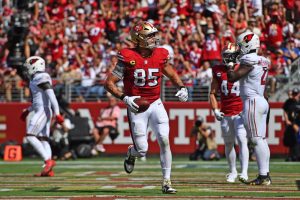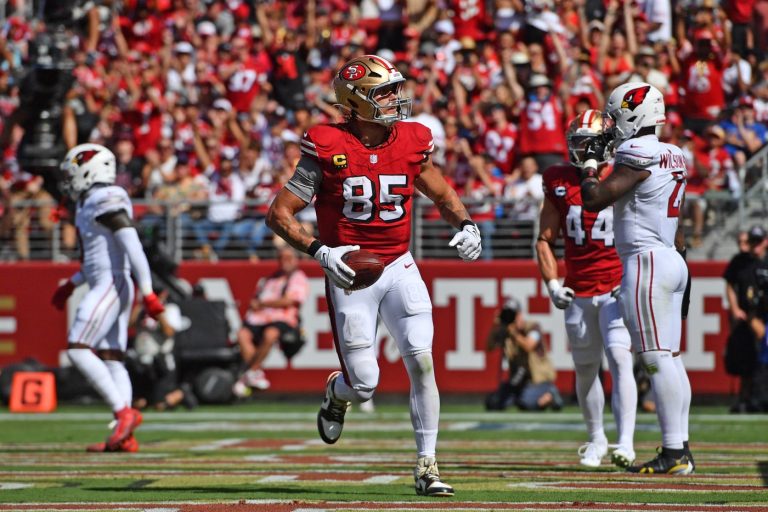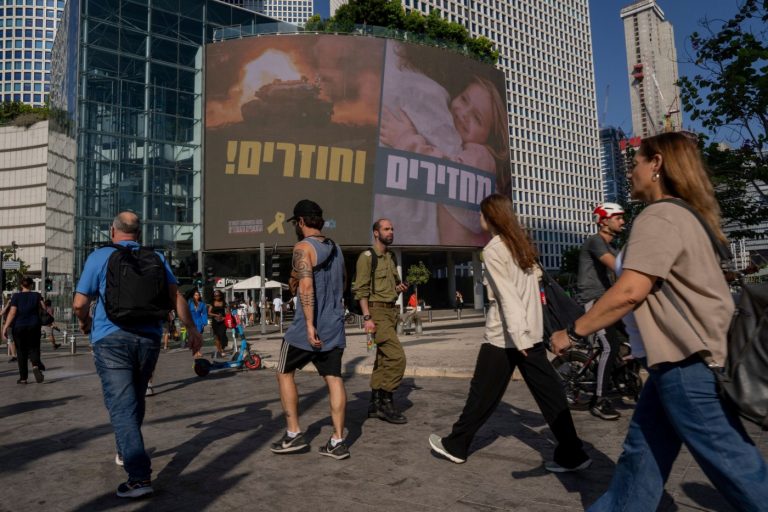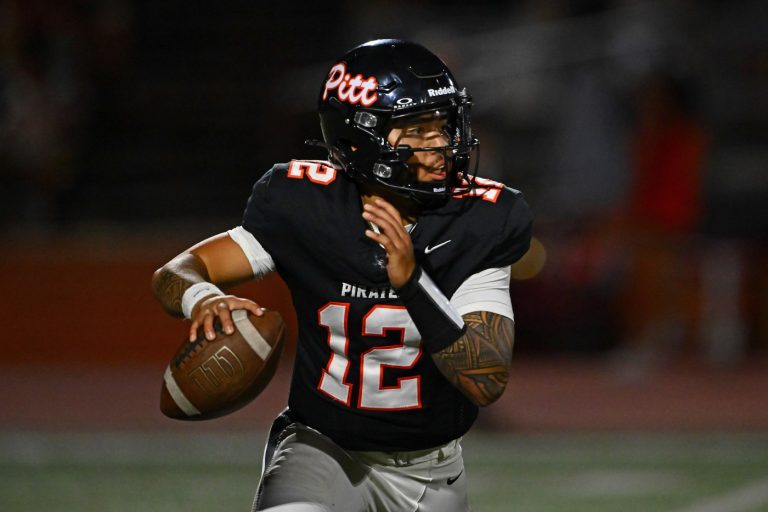LAS VEGAS — When the 49ers offense takes the field in Allegiant Stadium, there’s a good chance they’ll be doing so with all their players lined up between the hash marks.
The tight formation, also known as condensed, has been a staple of head coach Kyle Shanahan’s offense for years. Teams can run it with a variety personnel groupings, on any down, with the quarterback under center or in the shotgun. They can call straight dropbacks, running plays or play-action out of the alignment.
Nobody does it more than San Francisco; this year’s 49ers offense have aligned at an average of 19.9 yards wide — the tightest since Next Gen Stats began tracking in 2017.
The trend provides a window into the mind of Shanahan. The play-calling savant who played receiver in college is always trying to find new ways to spring receivers open. His fascination with condensed formations, he said Wednesday, began in his first NFL job, as a quality control coach in 2004 with the Tampa Bay Buccaneers.
“I was drawing everything in books and stuff, and everything was drawn up in wide splits,” Shanahan said. “Nothing was tight splits. And I always looked at everything when I first started through a receiver’s standpoint.”
So, why does the tight formation work? NFL writer Ben Solak, who identified the trend in a piece for The Ringer, can explain.
“Tight formations create predictable coverages,” Solak wrote. “Because wide receivers are so close to the formation, they can more readily get involved in run blocking. Accordingly, safeties have to get into the box and defend the run. Defenses are forced to deploy single-high coverages to get that additional box safety—and with single-high coverages come isolated outside corners playing with that outside leverage. When you know what the safety shell is going to be, and you know the leverage of the corner, and you know both of these things pre-snap? Man, does hitting those in-breakers get easier.”
At first, for Shanahan, the alignment was just a way to give his receivers less instances in which their defensive backs would jam them at the line of scrimmage. It has since evolved, as Shanahan has, to incorporate more running plays by leveraging how safeties react to the formation.
The running part is key. Downfield blocking is an emphasis for every 49er receiver under Shanahan. In tight formations, wideouts are always in the play, so they never have an opportunity to throw a lazy block without the risk of sabotaging the play.
“It involves all 11 people in the run game,” fullback Kyle Juszczyk said. “At the same time, not hurting you being able to throw out of those formations. I think that’s the big reason why we have everything condensed, it’s so all those wide receivers are also involved in blocking. And there’s really never a play you can take off because you’re on the back side or you’re over there. That’s just not how we do it. Every single play, you’re involved, and defenses have to respect that.”
To block well, receivers need strength, effort and stamina. An ESPN article this year named Brandon Aiyuk the best blocking receiver in the league. When asked about how the strategy opens up the offense, though, Aiyuk’s first instinct was about route-running — another of his strengths.
“I personally like being in tighter, just because there’s more space to work with,” Aiyuk said.
With more space compared to when he lines up out wide, like traditional No. 1 receivers, Aiyuk’s route tree opens up. He can run digs over the middle, “whip” routes to the sideline, corners and posts — like he did on his 51-yard grab in the NFC Championship Game.
Defensive back Charvarious Ward knows just how difficult San Francisco’s condensed formations can be to defend. He lined up across them as a Chief, and again for the past two training camps. Defenses must react to both run and pass plays, all sorts of possible routes, identify motions, and avoid confusion at the line of scrimmage.
“It definitely makes it a little more challenging,” Ward said.
If countering condensed alignments is challenging for Ward, an All-Pro, it probably won’t be a layup for Kansas City in Super Bowl LVIII, either.











+ There are no comments
Add yours